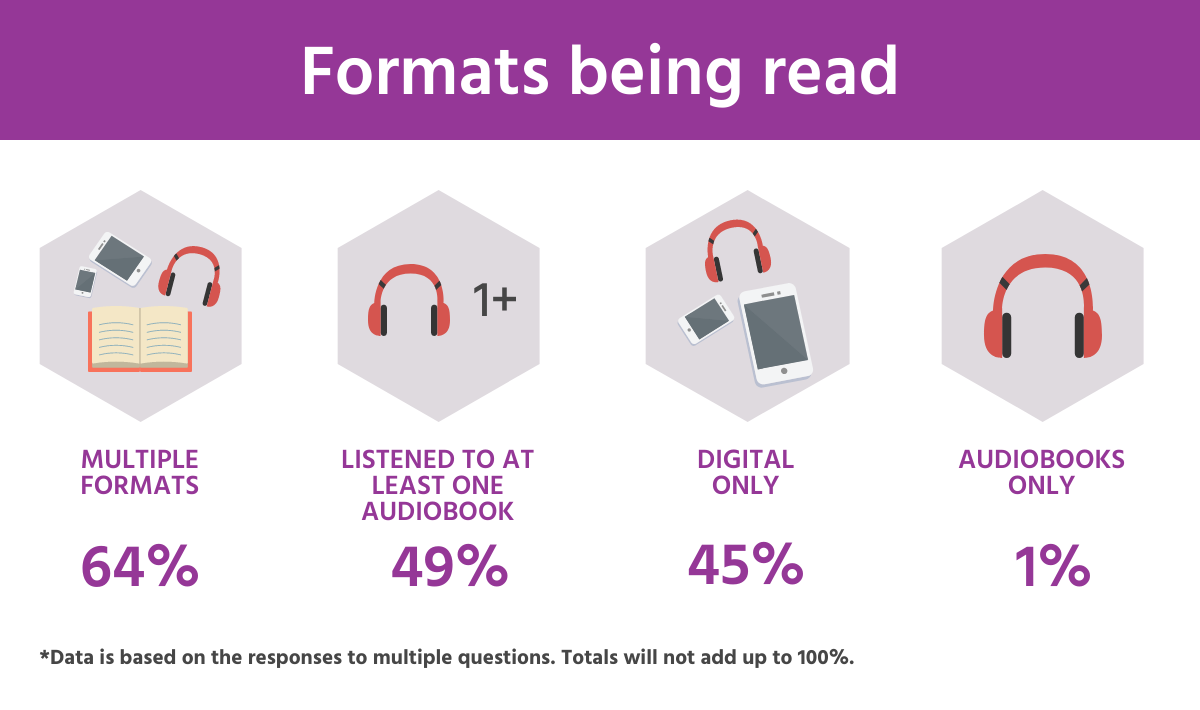At the beginning of this year, BookNet Canada surveyed 1,266 Canadians about their leisure and reading behaviours in 2019. We asked in-depth questions that helped us understand how Canadians spent their leisure time, identify changes from last year’s study results, determine reading preferences and trends, and more.
From the 1,266 people we surveyed, we identified 1,000 respondents who had read books in any format during 2019. Here are some highlights of the study. And, if you love data as much as we do, we highly encourage you to read the full Canadian Leisure & Reading Study 2020.
Without further ado, let’s begin!
Leisure time
First, we asked respondents about their perception of their leisure time during the past year. Was it enough? Most said yes: 53% of readers and 49% of non-readers said they had enough free time. Activities in which both groups engaged during their free time were: listening to music, watching videos/TV/movies, browsing social media, shopping, and spending time with family. Though readers are more likely to play board games, read magazines, listen to radio shows, dine out, and work on crafts.
Browsing social media/internet is the most frequent activity among both readers and non-readers, followed by watching videos/TV. Even though most respondents said that they never play video games, 19% of the readers said that they play once a week, while 15% of non-readers said that they play once a day.
We also got curious about the potential relationship between reading and listening to podcasts. It turns out that readers are more likely to listen to podcasts: 59% of readers confirmed that they listened to a podcast at least once during the last year, compared to 18% of non-readers.
Reading
By now, you should be wondering, “What about reading?” We’re glad you asked. Out of the 1,000 readers, in the past year 45% read digital books only, 49% listened to at least one audiobook, 64% read multiple formats, and 1% listened exclusively to audiobooks.
Most readers read frequently. The most popular responses across all three formats, print, digital, and audiobooks, were once a week (26%) and once a day (28%). 16% of ebook readers said that they read ebooks more than once a day.
Spending on books
We also found that books make perfect gifts — okay, maybe that’s not exactly what we can conclude. But about half of readers said that they spent the same amount of money on books for someone else as they did buying books for themselves.
Related to spending, we also see that finances play an important role when acquiring books, 41% of readers chose books within a set budget while 29% had no restrictions on their spending. In fact, we found that readers in the 18 to 29 age group tend to buy more than borrow across all formats and buy more than any other age group. But, are they the ones who read the most? Well, the short answer is not really. The long answer is that 75% of readers within the 18 to 29 age group are considered light to moderate readers, whereas almost 45% of the readers within the 65+ age group fall into the frequent and avid reader category, meaning that they read at least 12 books a year.
Book acquisition and discovery
So, where are all these readers getting their books, and how do they discover new titles? We thought you’d never ask. Turns out that 63% of readers borrowed a book from their local library at least once this past year, and online retailers and apps are the second most popular way to access digital books. Indeed, 83% of readers report to have purchased at least one book in any format. Only 5% of ebook readers accessed books through subscription services, compared to 11% of audiobooks listeners who report using these services more.
There are things about acquiring books that have changed during the last couple years, yet others remain almost the same; for instance, the number of readers buying physical books and audiobooks has increased, but when comes to print readers, they’re buying less at physical bookstores (remember, this was during 2019 when physical distancing was not yet a thing); and lastly, the frequency of informal lending among friends remains similar compared to data collected in 2018.
Book recommendation is a common discussion topic among colleagues, friends, and family; word-of-mouth was selected by 34% of readers as the top way they discovered books. It was followed by the bookstore and library which tied for second place, each with 29%, followed by online retailers (22%) and social media (18%). Discovering books on social media is mostly popular among Canadians living in the Western and Northern Territories. In our report, we've included detailed data about discoverability of books broken down by regions.
Even though readers discovered books in multiple ways, according to their responses we concluded that the main factor that drives them to read a book is its subject, followed by the author, then the book description. This applies to all book formats. Surprisingly, the fact that books have been made into a movie or nominated for literary awards ranked quite low as a reason to read a book, again, across all formats. Despite literary awards not being a major decisive factor, readers are familiar with some of them: the Governor General's Literary Awards (39% familiar), the Scotia Giller Prize (37%), and Canada Reads (27%).
Other things we learned
Mysteries or Thrillers are the most popular Fiction genres across all formats. In second place is Historical Fiction in the ebook and print formats.
Non-Fiction’s top two genres are History and Biographies or Memoirs. Self-Help is the most popular genre among readers 18 to 29 in audiobook and ebook format.
43% of readers searched for other books by the author of the book they were currently reading.
Most ebook readers adjust the screen magnification and font size/spacing to be larger, and ebook reading on smartphones continues to trend upwards.
Audiobook listening is primarily done via smartphone, the two most popular platforms are YouTube and Kindle.
Books by or about immigrants, BIPOC, religious minorities (non-Christian), disabled people, and those who identify as LGBTQIA+ are more likely to be read by frequent readers.
Thanks for getting this far, we promise that there’s a lot more to learn from the Canadian Leisure & Reading Study 2020 and remember that this is a free report you can share widely!



















Sales and library circulation data of Body, Mind & Spirit titles during the the first quarter of 2025.